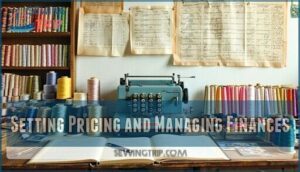This site is supported by our readers. We may earn a commission, at no cost to you, if you purchase through links.

Start by mapping out what you’ll teach and how students will progress from basic stitches to complete projects. Think about beginners who’ve never threaded a needle versus folks wanting to tackle advanced techniques.
Find a space with good lighting—natural light is best— and make sure there’s proper airflow since you’ll have multiple machines running.
Budget for quality sewing machines that won’t frustrate students, plus all the basics like thread, fabric, and notions.
Create a compelling brand identity and marketing strategy using social media and local partnerships. Smart pricing structures and referral programs will help build your student community. The secret sauce lies in balancing technical instruction with the creative freedom that keeps students coming back for more.
Table Of Contents
- Key Takeaways
- Market Research for Your Sewing School
- Choosing Your Sewing Specialization
- Planning Your Curriculum and Lesson Structure
- Setting Up a Suitable Space for Your Sewing School
- Acquiring Sewing Equipment and Supplies
- Hiring and Training Instructors (if Applicable)
- Marketing and Promoting Your Sewing School
- Setting Pricing and Managing Finances
- Building a Community and Retaining Students
- Continuous Improvement and Growth Strategies
- Frequently Asked Questions (FAQs)
- Conclusion
Key Takeaways
- You’ll need to conduct thorough market research first—survey your community for demand, analyze competitors’ pricing and offerings, and identify your target audience to ensure there’s sufficient interest before investing in equipment and space.
- Start with a structured curriculum that progresses logically from basic skills to advanced techniques, focusing on project-based learning that gives students tangible results they can use and be proud of.
- Choose your location and equipment strategically—whether it’s a home studio, rented space, or community center partnership, ensure you have proper lighting, adequate workspace, and quality sewing machines that match your class size and budget.
- Build retention through community—create a welcoming environment, implement referral programs, celebrate student achievements, and offer progressive skill levels that keep learners advancing through your program.
Market Research for Your Sewing School
You’ll need to understand your local market before launching your sewing school to make certain there’s demand for your classes and to identify what sets you apart from competitors.
This research phase helps you determine your target students, best pricing, and the types of classes that’ll fill seats consistently.
Assessing Demand and Competition in Your Area
Start by getting to know your local market. Who’s actually interested in sewing classes in your area?
Hit up community centers, browse local fabric shops, and check out online groups where sewing folks hang out—that’s where you’ll find your future students.
Analyze competitors through market research: visit their classes, study pricing structures, and identify gaps in their offerings. Look for market trends like upcycling or sustainable fashion that create niche identification opportunities.
Use demand forecasting by surveying potential students about their interests and skill levels. Owners can potentially earn a solid income, with annual revenues varying based on location and class size.
Identifying Target Audience and Their Sewing Needs
Knowing your target audience is what turns your sewing school from just another class into something people actually want. Who are you trying to reach? Busy professionals who need quick wins, or retirees with time for complex garment projects?
Ask potential students about their current skills, what they want to make, and how they learn best. This tells you whether to focus on simple starter projects or dive into advanced techniques.
Consider these key factors when identifying your ideal students:
- Student Skill Levels – Complete beginners need different approaches than intermediate sewers
- Project Interests – Some want home décor while others crave fashion design
- Learning Styles – Visual learners prefer demonstrations; kinesthetic learners need hands-on practice
- Feedback Mechanisms – Regular check-ins help you adapt your sewing specialization to student needs
Analyzing Pricing and Marketing Strategies of Existing Sewing Schools
Pricing-strategy detective work separates successful schools from struggling ones. Study competitor pricing analysis and promotional offerings to understand market positioning. Examine their marketing channel effectiveness and customer acquisition costs to identify gaps in your area’s sewing workshop marketing landscape. A key factor in profitability is understanding sewing class profit margins.
| Pricing Element | Research Focus | Action Items |
|---|---|---|
| Class Rates | Document hourly vs. package pricing structures | Compare $25-35/hour drop-in rates to $400-525 bundles |
| Promotional Offerings | Track introductory discounts and referral programs | Note 35% enrollment boosts from trial sessions |
| Marketing Channels | Analyze social media engagement and local partnerships | Assess 35% conversion rate improvements from targeted ads |
| Value Proposition | Evaluate what competitors include in their pricing | Identify material costs, space quality, instructor expertise |
| Customer Acquisition | Calculate their marketing spend and student retention | Compare against 15% revenue allocation for digital marketing |
Choosing Your Sewing Specialization
You’ll need to choose your sewing specialization carefully since it determines your curriculum, pricing structure, and target student demographics.
Focus on techniques where you have demonstrated expertise and assess local demand to guarantee sufficient enrollment for sustainable business growth.
Deciding on The Type of Sewing Classes to Offer (beginner, Advanced, Specific Techniques)
When you’re thinking about sewing classes, there are really three paths that work well. You can focus on beginners who need to learn the basics—think straight seams, simple hems, maybe their first tote bag.
Or you might go after more experienced sewists who want to tackle complex stuff like tailoring or drafting their own patterns.
The third option is getting really specific—maybe you become the go-to place for quilting or embroidery. Whatever direction you pick will determine everything from what supplies you need to which students walk through your door.
- Beginner Sewing – Basic skills like straight seams, buttonholes, and simple garment construction
- Higher-Level Classes – Complex techniques including tailoring, pattern drafting, and couture methods
- Technique Specialization – Focused areas like quilting, embroidery, or alterations
- Project-Based Learning – Structured courses combining multiple skills through completed items
Consider Skill-Based Progression when planning your sewing techniques offerings.
Determining The Projects and Skills to Focus On
Once you’ve chosen your class types, it’s time to map out skill-based projects that’ll keep students hooked. Start with student interests—ask what they want to create, then build curriculum relevance around those desires.
Match project complexity to skill levels, making technique mastery grow progressively. Focus on practical sewing techniques like garment construction and sewing patterns that students can actually use, making your curriculum development both meaningful and marketable.
Considering The Expertise and Qualifications Needed for Each Specialization
Different sewing specializations demand specific instructor credentials and industry experience. Fashion design teachers generally need bachelor’s degrees, while quilting instructors require completion of five specific patterns plus two years of teaching experience.
Children’s sewing instruction focuses on age-appropriate skill development starting around age eight.
Complex specializations like tailoring demand four years of hands-on experience and mastery of complex techniques. Assess your specialization depth honestly—continuous learning through workshops and certifications builds credibility with students.
Planning Your Curriculum and Lesson Structure
Setting up your students for success starts with building a solid curriculum that breaks down what they’ll learn and keeps lessons bite-sized and doable.
Good course design means mixing hands-on sewing time with the theory they actually need, so students can move step-by-step from threading a needle to tackling more complex projects.
Creating a Structured Curriculum With Clear Learning Objectives
After picking your sewing niche, you’ll want to tackle curriculum planning next. Start with clear learning goals for each lesson—students should know exactly what they’re walking away with, whether that’s nailing their first straight seam or finishing a complete garment.
Build your skills map logically, making sure each technique prepares students for what’s coming next without throwing beginners into the deep end. Project-based lessons work great here since students stay motivated while you get built-in ways to see how they’re progressing.
- Define measurable learning objectives: Students will know exactly what they’ll accomplish by each class’s end, from mastering straight seams to constructing complete garments
- Map skill progression pathways: Build knowledge systematically, making sure each technique gets students ready for the next challenge without overwhelming beginners
- Design flexible curriculum frameworks: Allow room for different learning paces while maintaining structure, so fast learners stay challenged and slower learners feel supported
Breaking Down Lessons Into Manageable Steps and Projects
Since effective curriculum planning requires systematic project scaffolding, you’ll need to create step-by-step learning progressions. Your lesson plan should emphasize skill sequencing and student pacing through adaptive learning approaches. Each project must demonstrate step clarity, allowing students to master techniques gradually.
| Beginner Projects | Mastery Projects |
|---|---|
| Straight seam practice | Fitted garment construction |
| Simple tote bag | Well-made blazer creation |
| Basic hem techniques | Professional finishing methods |
| Button attachment skills | Pattern drafting fundamentals |
Developing a sewing curriculum with clear teaching methods ensures student success through manageable skill progression.
Balancing Theory and Practical Hands-on Experience in Your Classes
Effective sewing education balances theory with immediate application to accommodate different learning styles. Your hands-on ratio should favor practical work—aim for 30% theory, 70% practice. This approach reinforces skills through repetition while building confidence.
Consider these strategies for developing a sewing curriculum:
- Start lessons with brief demonstrations, then move to guided practice
- Match project complexity to student skill levels for ideal learning
- Rotate between individual work and group activities for skill reinforcement
- Use visual aids during theory portions to aid kinesthetic learners
- End each session with students showcasing their progress
Teaching sewing techniques requires this balanced approach—students need to understand the "why" before mastering the "how.
Setting Up a Suitable Space for Your Sewing School
Setting up your sewing classroom right makes all the difference for your students. Start with the basics: sewing machines that actually work, cutting tables at the right height, and storage that keeps everything where students can find it.
Your room layout shapes how well students learn, so think about lighting first—nobody can sew well squinting at their work. Add comfortable seating and make sure supplies are easy to grab when students need them.
Identifying Potential Locations for Your Sewing School (home, Rented Space, Community Centers)
Setting up your sewing school starts with finding the perfect location that fits your vision and budget. Each option offers unique advantages for community building and classroom setup:
- Home Studio: Transform your spare room into an intimate sewing studio with custom Location Ambiance and lower overhead costs
- Rented Considerations: Explore dedicated commercial spaces offering professional classroom setup with proper lighting and ventilation systems
- Community Partnerships: Partner with local centers providing built-in student networks while considering Accessibility Factors for all learners
Your Setting Up a Sewing School Space choice impacts everything from space setup logistics to long-term growth potential.
Assessing The Space Requirements (tables, Sewing Machines, Storage)
Machine placement becomes critical when planning your sewing studio layout. Calculate table dimensions allowing 36-48 inches between each sewing machine for comfortable movement.
Plan storage solutions for fabric, notions, and tools within arm’s reach. Consider ergonomic considerations like proper lighting and seat height.
Address accessibility needs with wheelchair-friendly pathways. Your classroom setup directly impacts learning success.
Ensuring a Comfortable and Conducive Learning Environment
Transform your sewing classroom into a haven where creativity flourishes. Prioritize ergonomic considerations with adjustable chairs and proper table heights. Install quality lighting design—both natural and LED task lights reduce eye strain.
Maintain excellent air quality through ventilation systems. Implement noise reduction with sound-absorbing materials and designated quiet zones.
Focus on layout optimization, guaranteeing smooth traffic flow around sewing equipment. These thoughtful touches create an inspiring learning environment where students thrive.
Acquiring Sewing Equipment and Supplies
Getting the right equipment is crucial for your sewing school. The machines and tools you choose will directly impact how well your students learn and whether your classes actually work.
Start by calculating how many sewing machines you’ll need based on your class size, then focus on sourcing quality machines and essential supplies that fit your budget while meeting your students’ educational requirements.
Determining The Number of Sewing Machines Needed for Your Classes
Between your class size and budget allocation, you’ll want roughly one machine per two students for ideal learning flow. Consider the student-machine ratio carefully—sharing promotes collaboration while preventing overcrowding.
Factor in machine maintenance needs when planning your sewing equipment inventory. Different machine types serve various sewing classes, so align your purchases with your curriculum focus for your sewing school setup.
Sourcing Quality Sewing Machines and Accessories Within Your Budget
Once you’ve calculated machine quantities, smart Budget Planning becomes your next priority. Finding quality sewing equipment doesn’t mean breaking the bank. Here’s your roadmap to Cost Optimization:
- Machine Selection: Research reliable mid-range brands offering instructor training and warranties
- Refurbished Options: Purchase certified pre-owned machines from reputable dealers
- Accessory Options: Buy essential attachments first, expand gradually as classes grow
- Equipment Maintenance: Factor in annual service costs when comparing sewing machine prices
Acquiring Sewing Equipment and Supplies strategically ensures your sewing schools launch successfully without overspending.
Creating a List of Essential Sewing Supplies for Your Students
Beyond sewing machines, your students need extensive sewing supplies to master their craft. Create detailed sewing kits containing thread colors, notion essentials like pins and seam rippers, and various scissor types for different tasks.
Include fabric selection guides and cutting templates to improve the learning environment in your sewing classes, guaranteeing students have quality sewing equipment for successful projects.
Hiring and Training Instructors (if Applicable)
You’ll need qualified instructors who can effectively teach your curriculum and connect with students at different skill levels.
Start by evaluating whether your class size and student demand require additional teaching staff beyond yourself, then focus on finding experienced sewers who possess both technical expertise and teaching abilities.
Assessing The Need for Additional Instructors Based on Class Size and Demand
Once you’ve secured your sewing machines and supplies, you’ll need to determine your instructor ratio. Start by calculating class capacity against your projected demand forecast.
Most sewing schools maintain a 1:6 instructor-to-student ratio for ideal learning environments. Consider different staffing models based on growth projections—will you teach solo initially, or does demand justify hiring additional instructors immediately?
Identifying Qualified Sewing Instructors With Teaching Experience
Finding the right instructors is like assembling your dream team. You’ll want candidates who blend sewing expertise with proven teaching methods and genuine passion for student success.
Key qualifications to seek:
- Professional sewing experience – Look for instructors with at least five years of hands-on industry work or formal certification from recognized programs
- Teaching background – Prioritize candidates who’ve taught sewing classes, with 67% of formal instructors having completed certification courses in sewing instruction
- Communication skills – Seek those who can adapt pedagogy methods to different learning styles and demonstrate patience with beginners
Check references thoroughly and request teaching demonstrations during interviews.
Providing Training and Guidance to Instructors on Your Curriculum and Teaching Methods
Successful instructor onboarding requires structured staff development to align teaching methods with your curriculum. Create thorough training sessions covering your specific teaching techniques and curriculum alignment strategies.
- Develop detailed instructor manuals outlining your teaching philosophy and classroom management approaches
- Conduct hands-on workshops where instructors practice delivering lessons using your established methods
- Implement teacher mentorship programs pairing experienced staff with new hires for ongoing assistance
- Schedule regular feedback sessions to improve teaching techniques and address curriculum development needs
- Establish clear assessment criteria guaranteeing consistent quality across all sewing classes and instructors
Marketing and Promoting Your Sewing School
Getting the word out about your sewing school helps you find students who get excited about the same things you do – turning fabric into something amazing.
Building a solid brand and using smart marketing tactics shows off what you know while creating a space where people actually want to learn together.
Creating a Compelling Brand Identity and Logo for Your Sewing School
Your brand identity acts as your school’s visual handshake with potential students. Start with brand positioning that reflects your teaching philosophy and target audience needs. Choose colors using color psychology—warm blues build trust, while greens suggest growth. Select typography that balances professionalism with creativity.
| Brand Element | Purpose |
|---|---|
| Logo Design | Creates instant recognition and memorability |
| Color Psychology | Influences emotional connection with your school |
| Typography Selection | Conveys personality and professionalism |
| Visual Identity | Establishes consistent look across materials |
| Brand Positioning | Differentiates you from competitors |
Developing a Marketing Strategy to Reach Your Target Audience
When developing your marketing strategy, think beyond basic advertising to create genuine connections with your target audience. Start by mapping out where your ideal students spend their time—craft stores, fabric shops, community centers, or online sewing groups.
Build your brand identity around what makes your school unique, whether it’s beginner-friendly classes or specialized techniques.
Use social media for authentic content creation that showcases student projects and behind-the-scenes moments. Email marketing keeps past students engaged while attracting new ones through valuable sewing tips and class announcements.
Utilizing Online Platforms, Social Media, and Local Advertising to Promote Your Classes
Beyond traditional methods, you’ll broaden your reach through strategic online platforms and targeted local advertising. Launch Social Media Ads on Facebook and Instagram to showcase student projects. Enhance Local SEO so nearby searchers find you first.
Build Email Marketing campaigns featuring success stories. Partner with craft influencers for authentic endorsements.
Create Online Courses as lead magnets. Implement a student referral program with incentives—happy students become your best marketers.
Setting Pricing and Managing Finances
You’ll need to establish clear pricing structures that cover your costs while remaining competitive in the market.
Creating a strong financial management system from day one ensures you can track expenses, monitor cash flow, and make informed decisions that keep your sewing school profitable and sustainable.
Determining The Pricing Structure for Your Classes (hourly, Per Session, Package Deals)
Your pricing strategy becomes the foundation of your sewing school’s financial success. Choose from hourly rates ($18 average nationally), per-session pricing ($38-50 for group classes), or package deals offering 20% savings.
Consider your target audience’s budget and local competition when setting course fees. Flexible pricing during peak periods can boost profit margins, while discount strategies attract new students and generate steady revenue streams.
Calculating The Cost of Materials, Equipment, and Overhead Expenses
Accurate overhead calculation forms the backbone of your sewing school’s financial management and pricing strategies. You’ll need to crunch numbers for material costs, sewing equipment depreciation, and operational expenses to build a solid business plan.
- Material Costs: Calculate fabric, notions, and project supplies per student, factoring in bulk purchasing from your supply chain
- Equipment Expenses: Include machine maintenance, replacement costs, and utility bills for running multiple sewing stations
- Overhead Calculation: Add rent, insurance, marketing, and administrative costs, then divide by expected student enrollment
Establishing a Financial Management System to Track Income and Expenses
Getting your sewing school’s money matters sorted early saves you headaches later. Think of financial planning as laying a solid foundation—without it, everything else gets shaky.
You’ll want to track expenses and analyze your budget regularly to stay in the black. Here’s what you need to set up:
- Choose accounting software for automated expense tracking and cash flow monitoring
- Create monthly budget analysis reports comparing projected versus actual revenue generation
- Establish separate business accounts for clear financial management separation
- Document all pricing strategies and revenue streams in your thorough business plan
Building a Community and Retaining Students
Here’s the thing—you won’t just get students through one class and never see them again.
Instead, you’ll turn them into people who keep coming back because they genuinely connect with what you’re teaching and feel inspired to keep exploring.
Your retention strategy should focus on building meaningful relationships through consistent engagement, celebrating student achievements, and establishing clear pathways for skill progression that keep them coming back for more.
Creating a Welcoming and Supportive Learning Environment
Your classroom setup sets the foundation for success. Create a space where students feel comfortable making mistakes and celebrating wins together. Focus on these essential elements:
- Diverse Learning Styles: Accommodate visual, auditory, and hands-on learners through varied teaching methods
- Open Student Feedback: Encourage questions and suggestions to improve your sewing classes continuously
- Teacher Assistance: Provide individual attention while fostering peer-to-peer learning opportunities
- Community Building: Design group projects that connect students beyond individual skill development
- Flexible Environment: Adapt your learning environment to different skill levels and project needs
Implementing a Student Referral Program to Encourage Word-of-mouth Marketing
Your supportive environment becomes your marketing powerhouse when you implement referral incentives. Create a student referral program offering class discounts or supply credits for successful recommendations. Turn satisfied students into student ambassadors who naturally share their positive experiences.
Use social media promotion to boost these word-of-mouth strategies, encouraging posts about referral rewards. This marketing strategy builds customer loyalty while expanding your target audience through trusted recommendations on online platforms.
Continuous Improvement and Growth Strategies
Your sewing school’s success depends on embracing continuous improvement and business growth. Customer feedback becomes your roadmap for creative strategies that keep students engaged. Monitor market trends to identify emerging techniques and expand your offerings strategically.
- Develop sophisticated workshops based on customer feedback and skill progression
- Launch online marketing campaigns to reach students beyond your local area
- Create seasonal classes that align with current market trends and holidays
- Build community engagement through social media challenges and student showcases
- Implement a growth mindset by regularly updating curriculum with pioneering techniques
Frequently Asked Questions (FAQs)
What are the best ways to market my sewing school?
Target local Facebook groups, partner with fabric stores, offer free intro workshops, utilize Instagram tutorials, and build word-of-mouth through satisfied students. You’ll attract dedicated learners who’ll spread your reputation organically.
How much should I charge for my sewing classes?
Pricing rates can absolutely make-or-break your business empire! Research local competitors charging $32-40 per hour, then price competitively.
Factor in your experience, materials, space costs, and desired profit margin to set sustainable rates.
What kind of equipment and supplies do I need for my sewing school?
You’ll need quality sewing machines, cutting mats, rotary cutters, scissors, measuring tools, seam rippers, pins, threads, and basic fabrics. Consider storage solutions and comfortable workspace furniture too.
How can I find qualified instructors to teach my classes?
Like assembling a master quilting circle, you’ll find talented instructors by networking at local fabric shops, contacting fashion design schools for recent graduates, and posting on sewing forums where passionate seamsters gather naturally.
How can I build a community and retain students at my sewing school?
Create member perks like early workshop access and project discounts.
Host social events, celebrate student achievements, and encourage peer mentoring.
Offer progressive skill levels to keep students advancing through your program.
What insurance coverage do sewing schools need?
Insurance shields your workshop like armor shields a knight in battle. General liability insurance is essential to protect against student injuries and property damage.
Consider additional coverage such as professional liability, property insurance, and workers’ compensation if you hire instructors.
How do you handle student injuries?
Stay calm and assess the injury immediately. Have a first aid kit nearby and know basic procedures.
Call emergency services for serious injuries. Document everything and contact your insurance provider promptly.
What are the licensing requirements?
You’ll need a general business license from your city or county. While there aren’t specific sewing school licenses, check local zoning laws for home-based operations and consider liability insurance for protection.
How do you manage fabric waste?
Scraps pile up fast, but you’ll transform them into teaching gold.
Set up designated scrap bins by fabric type, teach students to save usable pieces for future projects, and donate larger remnants to local schools or craft groups.
What age restrictions should you implement?
Consider age-appropriate motor skills when setting minimums. Most schools welcome ages 8+ for basic hand-sewing, 12+ for machine work. You’ll create safer, more successful learning experiences.
Conclusion
Success in how to start a sewing school isn’t just about thread and needles—it’s about creating a thriving educational business. You’ve now got the blueprint: from market research to community building, each step builds upon the last.
Remember, even master seamstresses started with their first stitch. Your school will grow organically as you improve your curriculum, expand your offerings, and watch students transform fabric scraps into masterpieces.
Even master seamstresses started with their first stitch—your sewing school will grow organically as students transform fabric scraps into masterpieces
The sewing community needs passionate educators like you.



















